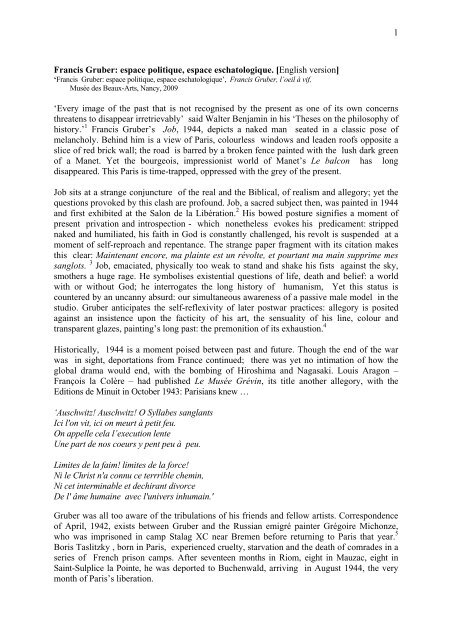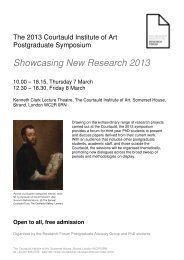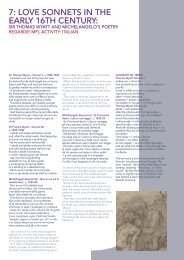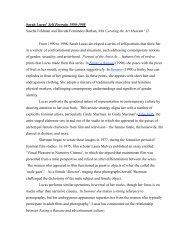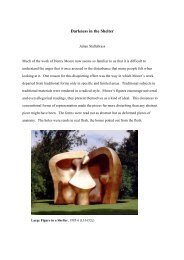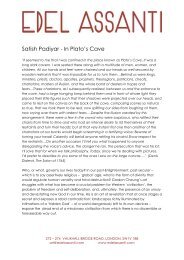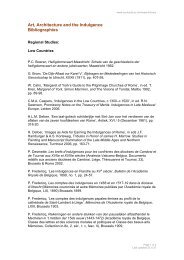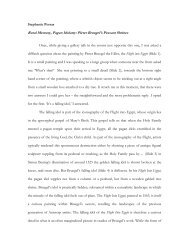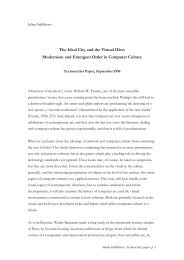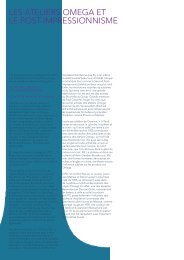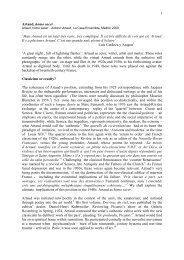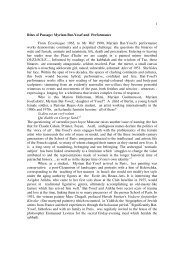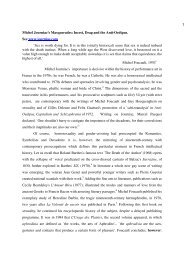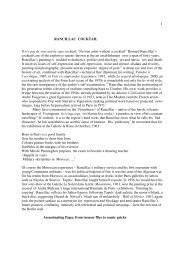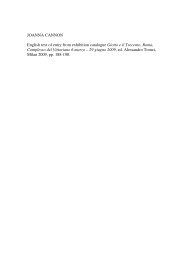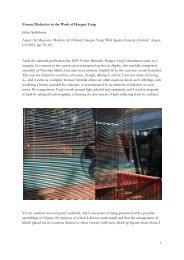Francis Gruber - The Courtauld Institute of Art
Francis Gruber - The Courtauld Institute of Art
Francis Gruber - The Courtauld Institute of Art
Create successful ePaper yourself
Turn your PDF publications into a flip-book with our unique Google optimized e-Paper software.
<strong>Francis</strong> <strong>Gruber</strong>: espace politique, espace eschatologique. [English version]<br />
‘<strong>Francis</strong> <strong>Gruber</strong>: espace politique, espace eschatologique’, <strong>Francis</strong> <strong>Gruber</strong>, l’oeil à vif,<br />
Musée des Beaux-<strong>Art</strong>s, Nancy, 2009<br />
‘Every image <strong>of</strong> the past that is not recognised by the present as one <strong>of</strong> its own concerns<br />
threatens to disappear irretrievably’ said Walter Benjamin in his ‘<strong>The</strong>ses on the philosophy <strong>of</strong><br />
history.’ 1 <strong>Francis</strong> <strong>Gruber</strong>’s Job, 1944, depicts a naked man seated in a classic pose <strong>of</strong><br />
melancholy. Behind him is a view <strong>of</strong> Paris, colourless windows and leaden ro<strong>of</strong>s opposite a<br />
slice <strong>of</strong> red brick wall; the road is barred by a broken fence painted with the lush dark green<br />
<strong>of</strong> a Manet. Yet the bourgeois, impressionist world <strong>of</strong> Manet’s Le balcon has long<br />
disappeared. This Paris is time-trapped, oppressed with the grey <strong>of</strong> the present.<br />
Job sits at a strange conjuncture <strong>of</strong> the real and the Biblical, <strong>of</strong> realism and allegory; yet the<br />
questions provoked by this clash are pr<strong>of</strong>ound. Job, a sacred subject then, was painted in 1944<br />
and first exhibited at the Salon de la Libération. 2 His bowed posture signifies a moment <strong>of</strong><br />
present privation and introspection - which nonetheless evokes his predicament: stripped<br />
naked and humiliated, his faith in God is constantly challenged, his revolt is suspended at a<br />
moment <strong>of</strong> self-reproach and repentance. <strong>The</strong> strange paper fragment with its citation makes<br />
this clear: Maintenant encore, ma plainte est un révolte, et pourtant ma main supprime mes<br />
sanglots. 3 Job, emaciated, physically too weak to stand and shake his fists against the sky,<br />
smothers a huge rage. He symbolises existential questions <strong>of</strong> life, death and belief: a world<br />
with or without God; he interrogates the long history <strong>of</strong> humanism, Yet this status is<br />
countered by an uncanny absurd: our simultaneous awareness <strong>of</strong> a passive male model in the<br />
studio. <strong>Gruber</strong> anticipates the self-reflexivity <strong>of</strong> later postwar practices: allegory is posited<br />
against an insistence upon the facticity <strong>of</strong> his art, the sensuality <strong>of</strong> his line, colour and<br />
transparent glazes, painting’s long past: the premonition <strong>of</strong> its exhaustion. 4<br />
Historically, 1944 is a moment poised between past and future. Though the end <strong>of</strong> the war<br />
was in sight, deportations from France continued; there was yet no intimation <strong>of</strong> how the<br />
global drama would end, with the bombing <strong>of</strong> Hiroshima and Nagasaki. Louis Aragon –<br />
François la Colère – had published Le Musée Grévin, its title another allegory, with the<br />
Editions de Minuit in October 1943: Parisians knew …<br />
‘Auschwitz! Auschwitz! O Syllabes sanglants<br />
Ici l'on vit, ici on meurt à petit feu.<br />
On appelle cela l’execution lente<br />
Une part de nos coeurs y pent peu à peu.<br />
Limites de la faim! limites de la force!<br />
Ni le Christ n'a connu ce terrrible chemin,<br />
Ni cet interminable et dechirant divorce<br />
De l' âme humaine avec l'univers inhumain.'<br />
<strong>Gruber</strong> was all too aware <strong>of</strong> the tribulations <strong>of</strong> his friends and fellow artists. Correspondence<br />
<strong>of</strong> April, 1942, exists between <strong>Gruber</strong> and the Russian emigré painter Grégoire Michonze,<br />
who was imprisoned in camp Stalag XC near Bremen before returning to Paris that year. 5<br />
Boris Taslitzky , born in Paris, experienced cruelty, starvation and the death <strong>of</strong> comrades in a<br />
series <strong>of</strong> French prison camps. After seventeen months in Riom, eight in Mauzac, eight in<br />
Saint-Sulplice la Pointe, he was deported to Buchenwald, arriving in August 1944, the very<br />
month <strong>of</strong> Paris’s liberation.<br />
1
As a young boy Taslitzky had worked for <strong>Gruber</strong>’s father and brother in the family stainedglass<br />
enterprise as a dessinateur: it was Jean-Jacques <strong>Gruber</strong> who first assessed his drawing<br />
skills, but <strong>Francis</strong> who filled him with delight and a certain envy <strong>of</strong> <strong>Gruber</strong>’s culture, talent<br />
and artistic equipment: A seize ans, sa culture artistique tenait du prodigue. L’ étendue de ses<br />
connaissances poétiques me donnait la vertige. Je me crus en presence de Raphaël, jeune et<br />
déja grand. 6<br />
<strong>Gruber</strong> was sixteen in 1928: the following year he would frequent the Académie<br />
Scandinave…He seems always to have been a fantaisiste, his child prodigy status and lack<br />
<strong>of</strong> conventional schooling due to his asthma, inevitably affecting his curious relationship with<br />
the adult world. A voracious reader, well versed in the European tradition <strong>of</strong> fairy tales, he<br />
was surely acquainted with the école fantaisiste itself, its figures such as Tristan Derème,<br />
Tristan Klingsor and <strong>Francis</strong> Carco, their desire to return to a burlesque, tempered with<br />
sentimentality, humour and melancholy …. 7 Early paintings such as Décor pour le bal de<br />
l’Académie scandinave, 1932, and particularly Le Triomphe des enfants, 1933, adopt devices<br />
from illustrated childrens’ books: figures jumping out <strong>of</strong> the overall perspective,<br />
disproportioned bodies with large heads and tiny legs, improbable postures that imply speed<br />
in running figures… flying figures, degenerate putti, masses smudged into visible graphic<br />
contours, a skirting with caricature… It is curious to compare these figures with Alberto<br />
Giacometti’s little-known political caricatures <strong>of</strong> this time, which coincided with Louis<br />
Aragon’s public adieu to surealism and his increasingly prominent involvement with the<br />
French Communist Party from 1927 onwards. 8 Giacometti’s studio in Alésia, was very near<br />
<strong>Gruber</strong>; they would become the closest <strong>of</strong> friends. Giacometti’s drawings were an act <strong>of</strong><br />
solidarity with Aragon: quand la politique m’avait separé de presque tous mes<br />
amis,[Giacometti] avait choisi de m’aider avec des dessins politiques…<br />
<strong>The</strong> front page <strong>of</strong> La Lutte anti-religieuse et prolétarienne, 59, April, 1932 is dominated by<br />
Giacometti’s Fête de charité’, where next to animal-headed bourgeois and a flic, a skinny<br />
Schiaparelli figure declares: Cette belle fête, mon général, nous permettra de construire une<br />
basilique à Saint Chiappe, patron des chomeurs… Below it is Aragon’s poem ‘Complainte<br />
des chomeurs’ - ending ‘Prolétaires de tous les pays, unissez-vous!’ 9 Similar images,<br />
Exploiteurs with capitalist and cleric on a crazy human-drawn sled, La Sale bête with a<br />
winsome pig (crucifix in arse) or Le nouveau-né , where a crocodile dog guards the cradle <strong>of</strong> a<br />
baby pierced with crucifix and tricolour, have a similar semi-naivety. 10 <strong>The</strong> analogies with<br />
<strong>Gruber</strong> – a certain infantilism - are striking, though the parallels are so different from those<br />
that may be established between the two artists’ later graphic work.<br />
If fantaisie entered politics via caricature here, it was surely not long before the allegory and<br />
fairy tale <strong>of</strong> Guber’s repertoire embraced more political paintings. Unlike the avant-garde <strong>of</strong><br />
the 1930s, <strong>Gruber</strong> as a very young painter submitted works to themed exhibitions: in 1932,<br />
Vénus et l’Amour rencontre une de leurs victimes was created for ‘La vie de Madame Vénus’<br />
(Galerie Carmine), while Le Rêve de la Petite Ida, 1932, (its theme taken directly from Hans<br />
Andersen) was for an exhibition on ‘La Danse’; the figure is poised with a doll-like stiffness<br />
between life and death. L’Arrivée des statues à Fontainebleau, 1935, is a transitional work.<br />
<strong>Gruber</strong> is a master <strong>of</strong> bathos: the Renaissance statue with its plinth leaning on a young boy’s<br />
shoulder punctures a scene that looks supsiciously like a fancy dress party; proletarians<br />
mingle and play in the background (even on a miniature scaffold); the boyish scowl and raised<br />
fist <strong>of</strong> the statue is humorous in its metamorphosis; the naked banderole bearers, too, are only<br />
semi-allegorical….<br />
2
While it was not <strong>Gruber</strong>’s Hommage au travail, 1936, that was shown in the militant<br />
exhibition ‘Le Réalisme et la peinture’, this key painting distinguished itself from its<br />
contemporaries with the same strategies <strong>of</strong> disjunction. France’s heritage <strong>of</strong> political protest in<br />
art provided palimpsests for many young artists:<br />
L'ardeur d'une dizaine de jeunes artistes à vouloir intégrer la vie révolutionnaire dans l'art, à<br />
prendre pour guides le Daumier de La Rue Transnonain, le Delacroix de La Barricade, plutôt<br />
que Cézanne ou Chardin, leur volonté de servir leur classe seraient assez puériles si elle ne se<br />
manifestaient qu'en intentions…. La commemoration joyeuse si bien ordonnée de Taslitsky, la<br />
rue de Mérangel, la vision tragique de Kuss, la figure de <strong>Gruber</strong>, etc..., sont plus que des<br />
promesses à une époque où la jeunesse manque, en general, si étonnamment de jeunesse.' 11<br />
<strong>Gruber</strong> himself, however, relates to the past with a conscious use <strong>of</strong> anachronism, not<br />
palimpsest. Le travail shows slightly sullen workers in the foreground, figures with placards<br />
crushed and spilling down the steps behind them, a minuscule procession diminishing towards<br />
the horizon. A half–built construction separates these two spaces (a favourite device) while<br />
semi-abandoned scaffolding structures the mid-ground. Strollers drag a toddler, in front <strong>of</strong><br />
clusters <strong>of</strong> little truants engaged in ‘children’s games’ (pace Breughel). <strong>The</strong> slightly mad<br />
flying figures are apparitions from an old master painting dragged into the present; they carry<br />
olive branch and laurel wreath, and straggling banderoles, declaring the day the fête du<br />
travail… Exquisite touches <strong>of</strong> red contrast with the workers’ blue and a generally<br />
monochrome colour scheme, s<strong>of</strong>tening the spiky graphic style. <strong>The</strong> mood, however, is <strong>of</strong><br />
disaffection rather than celebration, purposelessness rather than purpose, listless obsolescence<br />
rather a productive present in which aeroplanes dragging advertisments - rather than lost<br />
angels - were the harbingers <strong>of</strong> airborne capitalism. Fête du travail or strike? <strong>The</strong> whole<br />
paradox <strong>of</strong> the strike is intimated here: productivity crippled when ‘all hands’ come out <strong>of</strong> the<br />
factory into the political spaces <strong>of</strong> the city. Strikes rhymed both the making and the undoing<br />
<strong>of</strong> the French Popular Front.<br />
At what moment had Taslitzky introduced <strong>Gruber</strong> – the fils du patron, his family used to<br />
servants, a large car and chauffeur - to the milieu <strong>of</strong> the Association des Ecrivains et des<br />
<strong>Art</strong>istes Révolutionnaires (A.E.A.R.) and the Maison de la Culture? Or taken him to the<br />
Galerie Billiet-Worms, heavily involved in the Communist and anti-fascist struggle? (<strong>Gruber</strong><br />
surely found Pierre Vorms from Alsace-Lorraine with his German artist connections<br />
particularly congenial). In painting terms, the post-crash push for realism - while<br />
corresponding with organisational changes and style dogmas in the Soviet Union – was<br />
echoed by exhibitions in Paris: in 1934, which opened with ‘Le Retour au sujet’ at the Galerie<br />
Billiet-Worms, Courbet's Atelier was installed in the Louvre, the Ecole des Beaux-<strong>Art</strong>s held<br />
exhibitions <strong>of</strong> David, Ingres and Géricault; Maîtres de la Realité au XVIIème siècle moved from<br />
the Venice Biennale to the Orangeries, and Les le Nain - Peintures et dessins was held in the<br />
Petit Palais. By this time <strong>Gruber</strong> had found his painterly soulmates, Despierre, Ullmann and<br />
Tailleux with whom he exhibited at the Galerie Carmine; he probably visited Balthus’s show<br />
at the Galerie Pierre, with its cruel, Wuthering Heights-inspired, realist themes. 12 Did he<br />
attend the June 1935 Congrès des Ecrivains pour la Défense de la Culture ? He surely heard<br />
Louis Aragon’s lecture series at the Maison de la Culture, published as Pour un réalisme<br />
socialiste at the end <strong>of</strong> 1935. He became close to the Forces Nouvelles group, with whom he<br />
exhibited at the Salon de la Nouvelle Génération at the Galerie Charpentier; the ambiguities<br />
<strong>of</strong> their neo-humanist traditionalism was spelt out by Jacques Lassaigne, <strong>Gruber</strong>’s lifelong<br />
advocate: Ils nous présentent donc ce qui devrait être l'art académique de notre temps,<br />
3
c'est-à-dire d'une époque qui a connu le cubisme, La Fresnaye et le machinisme (avec ses<br />
conséquences sociales). 13 Far from academic, however, <strong>Gruber</strong>’s guileful play with motifs from<br />
the past insists upon the contemporary; his painting would soon leave the space <strong>of</strong> the atelier<br />
and spill onto the street, following the strikers, as Taslitzky recalls :<br />
'Le musée, nous le portions dans la rue, et c'est nous qui, en reproduisant à des dimensions<br />
colossales La rue Transnonain ou Le Tres de Mayo, avons rendu au peuple la connaisance de<br />
ses images les plus hautes, dans le temps où Aragon et quelques écrivains lui restituaient Hugo<br />
et la France….Tous ces visages nous les retrouvions triomphants au défilé populaire du 14<br />
juillet, coiffés de bonnets phrygiens en papier rouge à cocardes tricolores, fiers, disciplinés et<br />
chantant. Un million de personnes bras-dessus bras-dessous menait la grande farandole du<br />
pain, de la paix et de la liberté. La place de la Bastille nous avait servi de motif de<br />
décoration. S'appuyant sur la colonne de Juillet, les portraits gigantesques de Robespierre,<br />
Marat, Saint-Just, Mirabeau avaient été brossés par nous; chacun d'eux était encadré de<br />
motifs décoratifs et emblématiques dont Lurçat avait fournit la maquette et, du haut en bas de<br />
la colonne servant de mât, s'envolaient dans un ciel d'un bleu éclatant les oriflammes des<br />
provinces françaises. Dans le cortège nous avancions acclamés par tout un peuple en fête, à<br />
notre tête Aragon, Gromaire, Lurçat, Moussinac, Lipchitz, J. Richard Bloch, Sauveplane, des<br />
centaines d'écrivains, de musiciens, de peintres, de savants, de chanteurs, de scientifiques,<br />
d'acteurs... Nous les jeunes, nous portions les portraits des plus grands penseurs ou artistes<br />
de notre histoire. Je portais Jacques Callot peint en camayeu par <strong>Gruber</strong> et lui un Daumier<br />
de ma main.' 14<br />
<strong>The</strong> festivities for July 14th, 1936 marked a high point in Front Populaire mythology. Four days<br />
after ‘Le Réalisme et la peinture’ closed – the culmination with a new generation <strong>of</strong> the huge<br />
querelle du réalisme – <strong>Gruber</strong> found himself exhibiting with Picasso and Léger in the foyer <strong>of</strong><br />
the Alhambra theatre, renamed the ‘Théâtre Populaire'. Romain Rolland's play Le Quatorze<br />
juillet, written in 1902 as a revolutionary drama with ‘the people' as hero, commemorating the<br />
1789 revolution, involved over 150 actors and audience participation. Yet its conclusion:<br />
Forces obscures du monde, nous vous avons domptées, coincided with the ourbreak <strong>of</strong> the<br />
Spanish civil war… 15<br />
<strong>Gruber</strong>’s identification with Jacques Callot, then, dates from this time; his brother, Jean-<br />
Jacques <strong>Gruber</strong>, a student <strong>of</strong> Henri Focillon (recently appointed at the Sorbonne), was his art<br />
historical mentor. 16 Jean-Jacques’ involvement with historical maps surely impacted upon<br />
<strong>Gruber</strong>’s commision for a carte du monde historiée for the Ministère de la Marine Marchande. 17<br />
<strong>The</strong> landscapes and the religious or allegorical paintings and graphics <strong>of</strong> a Dürer, Altdorfer,<br />
Grunewald, or a Martin Schöngauer evidently fascinated <strong>Gruber</strong> more than the reprises <strong>of</strong><br />
French art by contemporary French artists. Contrasting with his condemnation <strong>of</strong> the<br />
international Surrealist exhibition <strong>of</strong> 1938 for the Journal des Peintres et Sculptuers de la<br />
Maison de la Culture, his praise for Max Ernst and Salvador Dali demonstrated oblique<br />
affinities : Cependant un Max Ernst et un Dali sortent victorieux de ces inutiles épreuves.<br />
Possédant une culture de l'atroce et un goût aussi délicat que celui des modistes, ils arrivent à<br />
être les parfaits décorateurs de l'absurde…' 18<br />
Compare <strong>Gruber</strong>’s L’Or ou la Preuve solitaire, 1936, dominated by fiend-suspended<br />
moneybags with Ernst’s L’Ange du foyer, 1937 – the ‘spectre haunting Europe’, whose<br />
reptilian monster is a magisterial allegory <strong>of</strong> fascism. This doubled beast emerged from the<br />
preying mantis-like creatures trapped and camouflaged in Ernst’s jungle paintings <strong>of</strong> 1936-<br />
7 which had personal and erotic undercurrents. How much more disturbing, was <strong>Gruber</strong>’s Les<br />
4
Malheurs d’amour, 1937. His series <strong>of</strong> humourously thick-set women, from Venus (1934) to<br />
the grumpy Printemps or L’Automne <strong>of</strong> 1937, and La Grande Mia - evidently a case <strong>of</strong> lovemelancholy<br />
– gives way to an imagery <strong>of</strong> violation : the agressed female figure is shockingly<br />
confrontational. <strong>The</strong> raped female as allegory <strong>of</strong> Spain became current at this time ( see works<br />
by S.W. Hayter, Edouard Goerg or André Fougeron’s Espagne Martyre….). In Les Malheurs<br />
d’amour, the woman, legs akimbo on a rock, lies exhausted after the event… <strong>The</strong> pedestal table<br />
from <strong>Gruber</strong>’s studio has been whisked to a new and desolate outside space : it lurches, about<br />
to crash; hobgoblins raise their arms; improbable fetish-parts are pierced with nails, their very<br />
illegibility part <strong>of</strong> the horror. Spied upon by garçon-voyeurs, the same woman appeared,<br />
discarded in a ditch, in <strong>Gruber</strong>’s otherwise reassuring, masterly self-portrait <strong>of</strong> 1935. Woman<br />
unmasters - as, indeed, does melancholy in the trope <strong>of</strong> woman….<br />
Again it is the half-real sense <strong>of</strong> woman’s violation in La Noyée, 1941, or even in the<br />
Hommage à Jacques Callot, 1942 that disturbs. <strong>Gruber</strong>’s quasi-sadistic self-inscription in these<br />
rape scenes, suggests a sense <strong>of</strong> complicity with death itself. 19 It is perhaps the moment to<br />
revive Giacometti’s vision <strong>of</strong> Jacques Callot, published in Labyrinthe, Geneva, in 1945 : Ce ne<br />
sont que des scènes de déstruction, de torture, de viol, incendie et naufrage…l’élément sexuel<br />
ou érotique n’est présenté chez Callot que par des viols, des martyres et par des allusions<br />
obscènes chez les bouffons. Le seule élément permanent et positif chez Callot c’est le vide, le<br />
grand vide béant dans lequels ses personnages gesticulants s’exterminent et s’abolissent… 20<br />
Images <strong>of</strong> ruin and decrepitude anticipate le vide : a repertoire <strong>of</strong> motifs, which pass from<br />
painting to painting. <strong>The</strong> swinging wooden door, opening onto nothing, is repeated with<br />
female figure juxtaposed in La Mélancolie, 1941 ; it becomes centre stage with La Poète,<br />
Hommage à Rimbaud, 1942 ; in a more realist setting it is substituted by the broken fence <strong>of</strong> La<br />
barricade with its prostrate women, now clothed, in the miserable area <strong>of</strong> la zone - a pendant to<br />
Job. Always these ‘realistic’ barriers act both as structural and compostional elements and as<br />
signifiers <strong>of</strong> thresholds : epistemological thresholds between real and artifical, present and<br />
imaginary, the model and the violated woman. Moreover, these binaries themselves imply the<br />
ultimate eschatological threshold, that between life and death. (<strong>Gruber</strong>’s use <strong>of</strong> stuffed birds<br />
and reptiles in his last still lives play with these ambiguities in a minor key).<br />
Evidently, the turn from plump, voluptous and brooding women to the small-breasted, halfstarved<br />
figures <strong>of</strong> the 1940 is significant.<strong>The</strong> fact that Cézanne’s Garçon au gilet rouge haunts<br />
<strong>Gruber</strong>’s model Etiennette, gives her an even more sexually ambiguous allure. <strong>The</strong> Nu au tricot<br />
rouge, back in the bare studio, in 1944 has lost many allegorical attributes ; a sense <strong>of</strong> erotic<br />
loss is still signalled by the Cupid with Venus effaced in the half-blank drawing behind her<br />
(compare the loose plaster arm suspended above in the Femme au gilet rouge avec chaise, 1948,<br />
a strange sign <strong>of</strong> mutilated masculinity). Yet, I would argue, woman was still too connotated ;<br />
even the wilful anti-eroticism <strong>of</strong> the clothed and listless model in Le Lit rouge implies a violent<br />
sexuality transposed to the magnificent carmine folds <strong>of</strong> the bed cover; <strong>Gruber</strong>’s Judith, 1946,<br />
with its murdered male figure in the background, is too overtly an image in which decapitation<br />
signifies castration. To return, then, to Job : a female figure could never function as a larger<br />
symbol <strong>of</strong> the human condition, or signal the fusion between a political and an eschatological<br />
space.<br />
It is the male nude who becomes the bearer <strong>of</strong> meaning in <strong>Gruber</strong>’s most concentrated images<br />
<strong>of</strong> the Occupation and immediate postwar period. While <strong>Gruber</strong>’s own wild hair, un boisson<br />
ardent – singifies his romantic disposition in both self-portraits, Job and L’homme nu, 1945<br />
(transposed to <strong>Gruber</strong>’s characteristic landscape) is older, balding ; he is the focus for a<br />
5
concentrated field <strong>of</strong> humanist associations - and significantly, figures as L´étranger, the<br />
stranger, the immigrant, in <strong>Gruber</strong>’s illustrations to Baudelaire’s Spleen, made at this time. 21<br />
<strong>Gruber</strong>’s allegorical impulse, now trapped in the coordinates <strong>of</strong> a cruel history, starts to<br />
signify dimensions where human behaviour itself becomes unimaginable: crimes <strong>of</strong> torture,<br />
murder, mass extermination, exercised laregly by men upon men as signifiers <strong>of</strong> their race or<br />
as political prisoners. Having shown Les cadavres in the exhibition <strong>Art</strong> et Résistance,in<br />
February, 1946, which was dominated by Picasso’s Le Charnier, <strong>Gruber</strong> referred to the camp<br />
as the very measure for the moral seriousness <strong>of</strong> contemporary art:<br />
‘Si au temps de Cézanne, peindre une pomme était une position intellectuelle tres avancée,<br />
faire de la peinture d’histoire au temps de Guernica et des camps d’extermination, est aussi<br />
une position intellectuelle et morale progressive… les magnifiques études de Giacometti<br />
pour le portrait du Colonel Rol-Tanguy, les nombreux dessins de Boris Taslitzky faits à<br />
Buchenwald sont à peu pres les seules témoignages de qualité des années que nous venons de<br />
vivre… ‘ 22<br />
Taslitzky’s La Pesée mensuel au prison de Riom – an indictment <strong>of</strong> the starvation <strong>of</strong> political<br />
prisoners in Vichy France, which raised disturbing parallels with the nazis, was almost<br />
concealed - along with <strong>Gruber</strong>’s contribution - at the back <strong>of</strong> the ‘Exposition de l’<strong>Art</strong><br />
Français’, held at the Musée de Luxembourg, in September, 1946... 23<br />
Like Antonin <strong>Art</strong>aud, <strong>Gruber</strong> would surely have made the effort, despite his illness, to visit<br />
the major Van Gogh retrospective, held at the Orangerie des Tuileries in January 1947.<br />
<strong>Gruber</strong>’s last works are contemporaries <strong>of</strong> <strong>Art</strong>aud, the emaciated and magnificent revenant,<br />
whose Van Gogh, le suicidé de la societé dressed an inquisition. <strong>Art</strong>aud’s accusation was <strong>of</strong><br />
crime, committed not only in Vichy France and Occupied Paris, but in the contemporary<br />
political spaces <strong>of</strong> towns and cities where cruelty, sadism and murder were rife.<br />
Contemporary research corroborates his disgust and virulent protest: the starvation <strong>of</strong> mental<br />
patients, sexual violence towards the tondues (around 20,000 women humiliated across<br />
France) the atrocities <strong>of</strong> the épuration… (as early as November 1944, the Minister <strong>of</strong> the<br />
Interior had allowed the figure <strong>of</strong> 100,000 purge victims to circulate) - and shadowing these<br />
the horror <strong>of</strong> concentration camp read in the face <strong>of</strong> every returned déporté. 24 What, indeed,<br />
happened one evening in Paris in 1946 - an apocalyptic moment that <strong>Art</strong>aud recalled in the<br />
‘postcript to the postscript’ <strong>of</strong> his text on Van Gogh? Et n’y eut-il pas un certain soir ou<br />
l’atmosphère de l’air et les rues devint comme liquide, gelatineuse, instable, et ou la lumière<br />
des étoiles et de la voute celeste disparut.? … A ‘massive unfurling <strong>of</strong> hatred’ he says, by<br />
people with ‘swinish souls’… 25<br />
Giorgio Agamben’s Bare Life, Homo Sacer, 1997, defines bare life, as ‘the life <strong>of</strong> homo sacer<br />
(sacred man) who may be killed and yet not sacrificed… the figure which elucidates not only<br />
‘the sacred texts <strong>of</strong> sovereignty but also the very codes <strong>of</strong> political power… the realm <strong>of</strong><br />
bare life… gradually begins to coincide with the political realm…’ Moving eloquently from<br />
Aristotle’s Politics to Michel Foucault’s biopolitics, he proceeds via a discussion <strong>of</strong> eugenics<br />
and their consequences to idea <strong>of</strong> the ‘<strong>The</strong> Camp as the ‘Nomos’ <strong>of</strong> the Modern’ …in some<br />
ways, he says, ‘as the hidden matrix and nomos <strong>of</strong> the political space in which we are still<br />
living.’ His touchstone is Robert Antelme’s camp memoir, L’Espèce humaine, first published<br />
in 1947. Agamben explains how, through historical and etymological progressions, homo<br />
sacer becomes one with ‘an outcast, a banned man, tabooed, dangerous… … accursed’ 26<br />
Accursed – and we may argue, cursing. Job’s cry, his suppressed curses, are those <strong>of</strong> the<br />
6
paradigmatic citizen-subject reduced to a state <strong>of</strong> ‘bare life’. Agamben’s crucial definition <strong>of</strong><br />
sovreignty in its relationship to ‘bare life’ stems from the early writings <strong>of</strong> Carl Schmitt - the<br />
German political theorist. 27 Schmitt visited Occupied Paris, publishing alongside Otmar von<br />
Verschuer, whose eugenicist blueprint, Etat et santé, appeared in 1942. 28<br />
Why this diversion ? Because <strong>of</strong> what happened in the political spaces <strong>of</strong> Paris itself – the<br />
‘realist’ background for ‘allegorical’ Job. Let us note that racial inflections extended to almost<br />
every contemporary analysis <strong>of</strong> the work <strong>of</strong> Frantz Joseph Albert <strong>Gruber</strong> who called himself<br />
the ‘last German painter <strong>of</strong> the Renaissance’, and whose alsacian father was protestant, his<br />
mother <strong>of</strong> Polish descent. 29 <strong>The</strong> ultimate Montparnassien, he experienced the rise<br />
antisemitism affecting his closest friends and mentors– Lipchitz at the Maison de la Culture,<br />
Michonze, Taslitzky. 30 At the height <strong>of</strong> the rafles in a Paris where thousands had flocked to<br />
the exhibition Le juif et la France, 1941, he married Georges Bernstein in 1942, the daughter<br />
<strong>of</strong> the Henri Bernstein, whose play Elvire had brought the issue <strong>of</strong> concentration camps onto<br />
the Parisian stage in 1939. 31 In the 1960s Jacques Bazaine, <strong>Gruber</strong>’s friend and dealer,<br />
recalled : ‘Par provocation, <strong>Gruber</strong>…se proclamait juif, narguait l’occupant et receuillait<br />
chez lui Boris Taslitzky evadé…’ 32<br />
Paris, once the space <strong>of</strong> an exalted political hope – <strong>Gruber</strong>’s Jacques Callot borne by<br />
Taslitzky in the street –had become a place <strong>of</strong> absences, <strong>of</strong> survivors, fraught with the terrible<br />
silences, the vision <strong>of</strong> the cadaver – himself – that Elie Wiesel brought back from<br />
Buchenwald. <strong>The</strong> suppressed sobs that Wiesel describes, repeat the paradigmatic situation <strong>of</strong><br />
Job : Aujourd’hui je n’implorais plus, Je n’étais plus capable de gémir. Je me sentais au<br />
contraire tres fort. J’étais l’accusateur. Et l’accusé: Dieu’…..<br />
…Assassins de mon pere! Mais le cri me restait dans la gorge….’ 33<br />
Just as a topological reading <strong>of</strong> the Book <strong>of</strong> Job may herald the promise <strong>of</strong> the New Testament,<br />
one may read the ‘release’ <strong>of</strong> female figures back into the delicate landscapes <strong>of</strong> féerie at the<br />
end <strong>of</strong> <strong>Gruber</strong>’s life as a new spring – poignant with the promise that the painter died too<br />
young to enjoy. Alberto Giacometti – so close to <strong>Gruber</strong> in his last moments–never betrayed the<br />
message <strong>of</strong> the war years in the terrifyingly thin bronzes that he repeated throughout his<br />
subsequent career. Postwar Paris flourished again by the later 1950s. Wiesel’s La Nuit, was<br />
published in 1958 at first – utterly out <strong>of</strong> its time. With the years it has become increasingly the<br />
concern <strong>of</strong> the present, a witness for millions. <strong>Gruber</strong> was, is, his contemporary, a prophet <strong>of</strong><br />
painting’s ruin and <strong>of</strong> the museum’s ruin. For the image <strong>of</strong> Job configures the image itself as<br />
‘an object <strong>of</strong> desire, the desire for the signification that is known to be absent’: a defining trait<br />
<strong>of</strong> postmodernism. 34 To see <strong>Gruber</strong>’s painting now is to enter his times again, via allegory,<br />
via conscious anachronism, and for a moment to question ourselves upon the thresholds <strong>of</strong><br />
meaning, which, with such courage, with such empathy, he proposed.<br />
L’œuvre de <strong>Francis</strong> <strong>Gruber</strong>, même lorsqu’elle est maladive, surtout lorsqu’elle est blessée, et<br />
lorsque enfin, elle triomphe dans cet éclat de joie que fut son dernier souffle, elle est nôtre… 35<br />
1 Walter Benjamin, spring 1940, quoted significantly by Craig Owens, ‘<strong>The</strong> Allegorical<br />
Impluse, Toward a <strong>The</strong>ory <strong>of</strong> Postmodernism’, October, 12, spring 1980, p. 67.<br />
2<br />
<strong>The</strong> work was purchase by the Tate Gallery in 1958; see Ronald Alley’s extended notes on<br />
Tate Modern website.<br />
7
3 Job, Chapter 23 verse 2; several different versions exist.<br />
4 <strong>Gruber</strong>: ‘Nous assistons à notre epoque à un carence de la peinture, causée par le fin de<br />
deux grands styles… ‘, ‘Interviews et Opinions, <strong>Francis</strong> <strong>Gruber</strong>’, interview with Madeleine<br />
Riffaud, <strong>Art</strong>s de France 5, 1946, p. 29; he calls modern painting ‘dégénerée’ in René Guilly,<br />
‘<strong>Francis</strong> <strong>Gruber</strong> cherche la liberté de la vision’, Combat, 15 September 1948. Compare Pierre<br />
Schneider: ‘le trouvaille de <strong>Gruber</strong> – qui n’est au fond qu’honnêteté - est de rester fidèle à la<br />
tradition sans en nier le déclin’, L’Express, 22 February, 1962.<br />
5 Grégoire Michonze (Michonzic) born in Kichnineff, (Bessarabia) Russia, trained in Bucarest<br />
and was close to the Romanian surrealists in 1930s Paris as well as <strong>Gruber</strong> and his circle.<br />
Parallels between their work are striking; see Grégoire Michonze, Paris, Galerie <strong>Francis</strong><br />
Barlier, 1997<br />
6 Boris Taslitzky, Tu parles, Chapter XXV, Paris, Les Editeurs Français Réunis, 1959, p. 131<br />
(Boris features as ‘Igor’, <strong>Gruber</strong> as ‘François Leber’).<br />
7 See http://fr.wikipedia.org/wiki/ École_fantaisiste<br />
8 <strong>The</strong> debate on a proletarian art and literature dominated the pages <strong>of</strong> Monde from December<br />
1930; Association des Ecrivains Révolutionnaires in Paris in 1931 was founded in response<br />
to the Kharkov congress <strong>of</strong> Soviet writers in 1930; its resolutions were not published until the<br />
October and November 1931 in the new four-language Soviet publication, Littérature de la<br />
Révolution Mondiale.<br />
9 This page <strong>of</strong> La Lutte… no 59, is reproduced and discussed in Leslie Rubin, <strong>The</strong> Lost Years,<br />
Alberto Giacometti’s Return to Figuration 1932-1937, MA thesis, <strong>Courtauld</strong> <strong>Institute</strong> <strong>of</strong> <strong>Art</strong>,<br />
London, 1990.<br />
10 See Rubin, op. cit., and Louis Aragon’s obituary for Giacometti, ‘Grandeur nature’, Les<br />
Lettres Françaises, 1, 115, 20 Janaury, 1966, pp. 1, 16-17, in Jean Ristat ed., Aragon, Ecrits<br />
sur l’art moderne, Paris, Flammarion, 1981, p. 217-218.<br />
11. See Georges Besson: ‘Les Expositions: La Querelle du Réalisme' L'Humanité, July 19th,<br />
1936; the third debate with young artists is not discussed by Serge Fauchereau in his re-edition<br />
<strong>of</strong> Aragon’s La Querelle du réalisme [1935], Paris, Cercle d’<strong>Art</strong>, 1987.<br />
12 See Antonin <strong>Art</strong>aud,. ‘Exposition Balthus à la Galerie Pierre’, La Nouvelle Revue<br />
Française, 248, 1 Mai, 1934; <strong>Art</strong>aud’s undated caricature, ‘<strong>Gruber</strong> , Louis XI ‘ is possibly a<br />
little later.<br />
13. Jacques Lassaigne, Almanach des <strong>Art</strong>s, Calendrier, October, 1937, in Forces Nouvelles,<br />
Musée d’<strong>Art</strong> Moderne de la Ville de Paris, 1980, np.<br />
14. Boris Taslitzky: ‘Le Front Populaire et les intellectuels' in La Nouvelle Critique,<br />
December, 1955, p. 15.<br />
8
15. See Romain Rolland. Théâtre de la Révolution. Le Quatorze Juillet, Paris, Albin Michel,<br />
1936, first performed, 1902; set in the Palais Royal, the Faubourg St Antoine and the Bastille,<br />
between July 12-14th, 1789.<br />
16 Jean-Jacques <strong>Gruber</strong>’s dévouement éclairé, son zèle infatigable are acknowledged in the<br />
preface to Joseph Calmette, Atlas historique, 1I, Le moyen age, Paris, PUF, 1936, p. 10 (the<br />
1951 reedition notes his talent de dessinateur); his souriante obligeance and inépuisable<br />
érudition are thanked in Louis Delaporte, Etienne Drioton, André Piganiol, Robert Cohen,<br />
Atlas historique, 1, L’Antiquité, Paris, PUF, 1937, p. 6.<br />
17<br />
<strong>The</strong> second edition <strong>of</strong> Atlas historique, 1I, Le moyen age, (PUF, 1951) salutes Jean-Jacques<br />
<strong>Gruber</strong>’s ‘talent de dessinateur’ (p. 8).<br />
18. <strong>Francis</strong> <strong>Gruber</strong>, 'Le Surréalisme' in Peintres et Sculpteurs de la Maison de la Culture, 4,<br />
March 1938, p. 39.<br />
19 See Denys Chevalier, ‘François <strong>Gruber</strong> reste le précurseur inégale de la jeune peinture né<strong>of</strong>igurative’,<br />
<strong>Art</strong>s, 741, 23 September, 1959. Hee notes une sorte de déléctation presque<br />
sadique dans l’exposé de ses visions morbides, cruelles ou amer…une complaisiance envers<br />
la mort transparaît en filigrane dans chacune de ses oeuvres comme un accord depuis<br />
longtemps signé.<br />
20 Alberto Giacometti, A propos de Jacques Callot, Labyrinthe, 7, 15 April, 1945, p.3.<br />
21 See L’Etranger, and the Job-like Saltimbanque in Baudelaire, Spleen, quinze petits poèmes<br />
en prose, Paris, Editions du Grenier à Sel, 1954, shown at the Librarie M. Sautier, 1954 and<br />
with drawings including for Aragon’s Les Voyageurs de l’Impériale, 1946, at the Galerie du<br />
Passeur, 1962.<br />
22 <strong>Gruber</strong>, <strong>Art</strong>s de France 5, 1946, op. cit., p.28 (the article begins with a full-page<br />
reproduction <strong>of</strong> Job, p. 26. ‘Témoignage par Boris Taslitzky,' was held at La Gentilhommière,<br />
June 1st-25th, 1946 see also his Cent-onze Dessins faits à Buchenwald , Paris, La Bibliothèque<br />
Française, 1946.<br />
23<br />
Giacometti wrote in protest to Aragon; the photocopy <strong>of</strong> his undated letter is in Boris<br />
Taslitzky’s archives.<br />
24 See Annette Wieviorka, ‘Témoinages et ouvrages parus avant 1948’, Déportation et<br />
genocide. Entre la mémoire et l’oubli, Paris, Plon, 1992, pp. 446-475; Max Lafont,<br />
L’extermination douce. La cause des fous. 40,000 Malades Mentaux morts de faim dans les<br />
hôpitaux sous Vichy, Latresne, Le Bord de l’Eau, 2000 (revised figure 76, 327 deaths, p. 205);<br />
Fabrice Virgili, La France “virile”. Des femmes tondues à la libération, Paris, Payot, 2000;<br />
<strong>The</strong> most recent estimates <strong>of</strong> épuration deaths are <strong>of</strong> 10-11,000; see for the statistical debate<br />
and most up-to-date bibliographies, http://fr.wikipedia.org/wiki/É puration_ à<br />
_la_Libération_en_France.<br />
25 …l’un de ces déferlements massifs de la haine…leurs âmes de bas porceaux…’ <strong>Art</strong>aud,<br />
‘Postscriptum’ to ‘Van Gogh, le suicidé de la societé, K, éditeur, 1947, p. 70.<br />
9
26 Giorgio Agamben, Homo Sacer, Sovereign Power and Bare Life, (1995), Stanford,<br />
Stanford University Press, 1998, he discusses Antelme, p. 10 etc.; homo sacer (Pompeius<br />
Festus); pp. 8-9, 71; suicide p. 136; the camp as the ‘nomos’ <strong>of</strong> the modern where ‘homo<br />
sacer is virtually confused with the citizen…’. 166-171 ff.<br />
27 For Schmitt in France see Considérations politiques, Paris, R. Pichon and R. Durand<br />
Auzias, 1942; Cahiers de l’<strong>Art</strong> allemand, 6, Quelques aspects du droit allemand, Paris, 1943.<br />
28 Agamben, op.cit., p. 53; see Otmar von Verschuer ed., Etat et santé, Cahiers de l’Institut<br />
allemand, Paris, F. Sorlot, 1942 (see also his Manuel d’eugénique et hérédité humain, Paris,<br />
Masson, 1943); he later experimented in Auschwitz.<br />
29<br />
See Catherine Bernard-<strong>Gruber</strong>, Armelle Vanazzi, <strong>Francis</strong> <strong>Gruber</strong>, Neuchâtel, Ides et<br />
Calendes, 1989, pp. 27, 152.<br />
30<br />
See Sylvie Buisson ed., Montparnasse deeporté, <strong>Art</strong>istes d’Europe, Musée de<br />
Montparnasse, 2005.<br />
31 See Georges Bernstein <strong>Gruber</strong> et Gilbert Maurin, Bernstein le magnifique, Paris, Lattès,<br />
1988; Chantal Meyer Plantureux, Les enfants de Shylock ou l'antisémitisme sur scène, Paris,<br />
Editions complexe 2005, notamment "L'affaire Bernstein, "le traite de théâtre" pp. 29ff.<br />
32 See Armelle Vanazzi, François <strong>Gruber</strong> et la critique, Mémoire de maîtrise, dir, Bruno<br />
Foucart, Paris-Sorbonne IV, 1987, p. 15, quoting Georges Charensol, Les grands maîtres de<br />
la peinture moderne (Lausanne, 1967) - claims evidently unsubstantiated.<br />
33 Elie Wiesel, La nuit, preface by François Mauriac, Paris, Les Editions de Minuit, p. 109-<br />
110; 170. T he first instance evokes the celebration <strong>of</strong> Jewish New Year in Auschwitz; the<br />
second the slow death <strong>of</strong> his father from dysentry in Buchenwald (compare the death <strong>of</strong><br />
Maurice Halbwachs, pr<strong>of</strong>essor at the Collège de France, witnessed by Taslitzky and Jorge<br />
Semprun in Buchenwald at the same moment).<br />
34 Douglas Crimp, On the Museum’s Ruins, Cambridge, Massachussetts, 1993, p. 183, quoted<br />
significantly by Nicolas Bourriaud, ‘Altermodern’, Altermodern, Tate Triennial, 2009, np.<br />
35 Boris Taslitzky, ‘Mon ami <strong>Francis</strong> <strong>Gruber</strong>’, L’Humanité, 3 novembre 1949, p. 3. He recalls<br />
that <strong>Gruber</strong>, was ‘assisté tout le temps que précéda et que dura son agonie par le sculpteur<br />
Giacometti’. <strong>Gruber</strong> joined the French Communist Party in the euphoria <strong>of</strong> Paris’s Liberation,<br />
preceding the debates on socialist realism which would subsequently involve his friend. At<br />
the Salon de la Jeune Peinture, 6-25 fevrier, 1954, <strong>Gruber</strong>’s work was heralded as crucial for<br />
a new generation <strong>of</strong> realist painters.<br />
10


